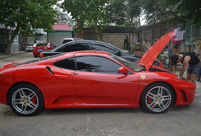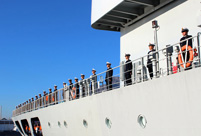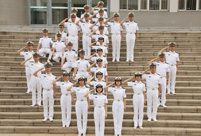 High speed train attendants receive training in Chongqing
High speed train attendants receive training in Chongqing
 Rare rainbow clouds seen in Fujian
Rare rainbow clouds seen in Fujian
 Small bracelet going global
Small bracelet going global
 Aerial Photography: Amazing Tianshan Mountains
Aerial Photography: Amazing Tianshan Mountains
 'Animals' in 2014 World Cup
'Animals' in 2014 World Cup
 Not afraid of death
Not afraid of death
 Chen Guangbiao ads on A15 of NYT to host charity luncheon for 1,000 poor and destitute Americans
Chen Guangbiao ads on A15 of NYT to host charity luncheon for 1,000 poor and destitute Americans
 Passionate bar babies and fans feel the charm of World Cup 2014
Passionate bar babies and fans feel the charm of World Cup 2014
 US aircraft carrier docks in HK, welcomes PLA aboard
US aircraft carrier docks in HK, welcomes PLA aboard
 Graduation season: 'Take graduation photos to mark our love'
Graduation season: 'Take graduation photos to mark our love'
BEIJING, June 29 -- In northwest China's vast sun-scorched desert, a camel train plods along the ancient Silk Road. The caravan bells sound as beautiful as they did some 2,000 years ago.
The 7,000 km road linking the Orient and Occident, was once jammed with caravans of Chinese silk, Indian spices and Persian brocade. Now the camels carry tourists from around the world.
"Those merchants must have been expecting a good price for their goods after all this hardship," said Beijing accountant Guo Ying, 25, after her bumpy camel ride.
Centuries after war and competition from sea routes brought decay, the Silk Road is rising again.
It was along the road that explorers and pioneers -- most famously the Middle Kingdom's imperial envoy Zhang Qian and the Venetian merchant and traveller Marco Polo -- introduced to their own people the other side of the world.
Both East and West are looking again at the routes that maintained stability and prosperity from China to the Mediterranean for many centuries.
At a construction site in northwest China's Jiayuguan, Chang'an and Mitsubishi trucks haul construction materials for a new train terminal. The high-speed link between Lanzhou and Xinjiang will soon be launched and passengers will travel at over 200 km per hour, at least 20 times as fast as on camelback.
"Caravans are quaint, but we need more railways and air routes," said Lou Qinjian, 58, governor of northwest China's Shaanxi Province, at one extremity of the route.
Lou's weather-beaten face shines with passion and perseverance. One year taking office, his province has found itself much nearer the center of Central Asia. Shaanxi now trains at least 1,000 students from Central Asian countries every year. Lou has organized direct flights between Almaty in Kazakhstan and Shaanxi's capital Xi'an.
Some 1,500 years ago, merchants from Central Asia, the Middle East and Western Europe braved the Gobi Desert and nomadic bandits to arrive at Chang'an, the historical name of Xi'an, then the world's largest metropolis. Getting cargo across the border today is much easier.
At the northwest land port of Horgos, customs procedures have been streamlined as the vast landlocked west is opened to Asian neighbors. Cross-border trade with Kazakhstan at Horgos is expected to grow by 14 percent by December.
President Xi Jinping's proposed "Silk Road Economic Belt" revival project could involve over 40 Asian and European countries and regions with a combined population of 3 billion.
For Chinese retailer Huang Jie in Kazakhstan, Xi's idea is great news. Over 20 years ago, Huang married a Kazakh man and started a store selling cooking utensils in Almaty, once a major logistic hub on the Silk Road. Almost all the goods in Huang's emporium are imported from China.
"They sell very well here," she said, evidenced by a daily turnover that can hit 9,000,000 tenge (around 50,000 U.S. dollars).
The caravan trade in Central Asia was mainly East to West from the 4th to 8th century, and dominated by the Sogdians, mostly from Uzbekistan. Uzbek Olimpiade, 52, is well known for his business acumen inherited from his Sogdian ancestors, and also for his mastery of Chinese culture, such as Kung-fu and calligraphy.
Olimpiade studied in the Confucius Institute at Tashkent and has been to China four times to learn Kung-fu. His latest epiphany is that martial arts and calligraphy share a lot in common. "Even with Kung-fu, the ancient Silk Road would have been too dangerous for me," he said.
Residents of Byzantine capital Istanbul would have agreed with Olimpiade. The city was the starting point for numerous arduous trips along the road over past millennia. Today, products from east China's Yiwu, the world's largest wholesale market, are piled high in Istanbul's Grand Bazaar.
Yavuz Onay, chairman of the Turkish Chinese Chamber of Commerce and Industry, is planning to make China a bigger business partner.
"I am endeavoring to be Marco Polo in the 21st Century," he said.
Onay gave up on universities in London and New York and went to Shanghai as a postgraduate. He now helps the Turkish to do business in China and brings Chinese investors to his country.
"To revive the Silk Road, we should have more camels installed with engines," he said. High-speed rail from Istanbul to Ankara and a Bosphorus rail tunnel between Asia and Europe are both part of Turkey's effort to make itself a key juncture on the new Silk Road.
"We have been in action to connect Turkey with Central Asia and Europe, even as far as Britain, with high-speed railways," said Omer Onhon, Deputy Undersecretary of the Ministry of Foreign Affairs of Turkey.
In southern China's Guangzhou City, Marco Polo also has his fans.
Among all the ports that contributed to the maritime Silk Road, Guangzhou is the only one where maritime trade never ceased.
Last year, Xi proposed the "Maritime Silk Road of the 21st Century" along the less well known ocean route that linked the Pacific and Indian Oceans.
Yemeni expat Ali Ismail Mahyiddin has found his fate closely related to the maritime Silk Road which made Guangzhou -- his current home -- a cultural and religious metropolis.
"Everyone here is always ready to help me," he said.
Mahyiddin runs his own restaurant in Guangzhou, serving both Chinese and Yemeni dishes. The name of his restaurant, Saba, refers to the Yemeni dynasty at the time when the maritime route thrived and brought the Arabian peninsula into the early global trading system.
The magic of the Silk Road continues. Over 20,000 Arabians were living in Guangzhou last year, with over 1,000 enterprises, offices and restaurants. Thirteen years after his first encounter with China -- an accidental business trip -- Mahyiddin is now waiting for a Chinese "green card", or permanent residence permit.
"I hope to get it as soon as possible," he said. "I am used to living here; this is my home."
 Female master poses for graduation photos with son
Female master poses for graduation photos with son Silk Road, China's Grand Canal listed as World Heritage Sites
Silk Road, China's Grand Canal listed as World Heritage Sites PKU students imitate famous paintings in real-person photos
PKU students imitate famous paintings in real-person photos Chinese 'Slumdog Millionaire'
Chinese 'Slumdog Millionaire' Puzhehei: land of idyllic beauty
Puzhehei: land of idyllic beauty Stewardesses in Brazilian soccer jerseys
Stewardesses in Brazilian soccer jerseys Chinese navy fleet visits Cape Town, South Africa
Chinese navy fleet visits Cape Town, South Africa PLA naval cadets toss their hats at graduation ceremony
PLA naval cadets toss their hats at graduation ceremony Graduation photo ideas: reliable alumnus and happy alumna
Graduation photo ideas: reliable alumnus and happy alumna Islands in S. China Sea better shown on new vertical atlas of China
Islands in S. China Sea better shown on new vertical atlas of China Girl takes father’s portrait to travel the world
Girl takes father’s portrait to travel the world Images of Xi'an: Part one
Images of Xi'an: Part one In Pictures: Female fans of World Cup
In Pictures: Female fans of World Cup Top 20 hottest women in the world in 2014
Top 20 hottest women in the world in 2014  China's top 10 representative architectures
China's top 10 representative architecturesDay|Week|Month